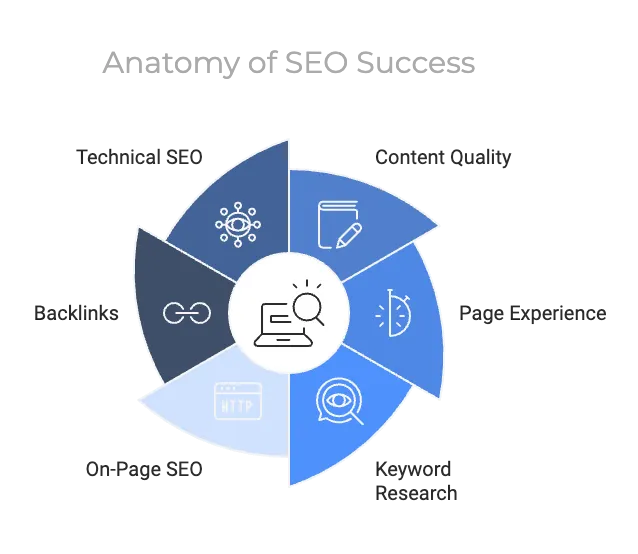The Importance of Page One Visibility
Ranking on the first page of Google is essential for driving organic traffic to your website.
Studies show that over 75% of users never go beyond the first page of search results.
This makes it crucial for businesses and content creators to implement SEO strategies that increase their visibility.
If your website is buried on page 10 or beyond, potential visitors may never find it.
Achieving page one visibility requires an understanding of how Google’s search algorithm works and what factors influence ranking.
From quality content to technical SEO, every element of your site plays a role.
The following sections will guide you through the process of improving your website's SEO and reaching the coveted first page position.

Why Page One Visibility Matters
The first page of Google captures nearly 90% of all search traffic.
This makes achieving a top position critical for businesses, bloggers, and marketers.
Studies show that users rarely venture beyond the first page, making visibility a determinant of success.
The psychological aspect is also vital.
When your website appears on the first page, it gains credibility and trust from users.
Businesses often find that being visible boosts brand awareness and drives organic leads.
But it's not just about being seen.
It’s about providing users with the answers they need while meeting Google’s stringent quality criteria.
Every click on the first page represents a potential customer, subscriber, or follower.
Core Elements of Google’s Algorithm
Google's algorithm evaluates hundreds of signals to rank websites.
Let’s explore the most impactful ones:
Content Quality and Relevance
Google prioritizes content that aligns with user intent.
Ensure your pages address queries effectively and provide in-depth, well-structured information.
Page Experience Signals
Factors like load speed, mobile-friendliness, and interactivity define a site’s page experience.
Sites that load within three seconds are more likely to rank higher.
Keyword Research: The Foundation of SEO
Keywords bridge user queries and your content.
Effective research is essential for visibility.
Tools for Effective Keyword Research
Leverage tools like Google Keyword Planner, Ahrefs, or SEMrush to identify high-value keywords.
Long-Tail Keywords for Niche Traffic
While broad terms attract volume, long-tail keywords target specific user intents, improving conversion rates.
Optimizing Content for Better Ranking
Content is king when it comes to SEO
High-quality, informative content not only attracts readers but also increases your chances of ranking on the first page.
Focus on creating content that answers users' queries comprehensively.
Start by conducting keyword research to find out what your audience is searching for.
Then, create content that provides real value by addressing these queries in-depth.
The more detailed and relevant your content, the better your chances of ranking higher.
Additionally, update your content regularly to keep it fresh and relevant.
Google tends to favor websites that provide up-to-date information.
Technical SEO: The Backbone of Google Ranking
Technical SEO is essential for ensuring that search engines can crawl and index your website correctly.
Without it, even the best content may not rank well.
Some key aspects of technical SEO include:
- Site speed: Slow websites lead to poor user experience and lower rankings.
- Mobile optimization: With the majority of users browsing on mobile, Google prioritizes mobile-friendly websites.
- Clean URL structure: Ensure your URLs are concise, relevant, and include keywords.
Implementing these technical SEO best practices will not only improve your ranking but also enhance the overall user experience.
On-Page SEO Techniques
On-page SEO forms the cornerstone of search engine optimization.
By optimizing elements on your website, you make it easier for Google to understand and rank your content.
Title Tags, Meta Descriptions, and Headers
The Title Tag
The title tag is one of the first things Google and users see.
Ensure it includes your primary keyword and is compelling enough to attract clicks.
Keep it under 60 characters for best results.
Meta Descriptions
While not a direct ranking factor, impact click-through rates.
Write concise, engaging descriptions that incorporate keywords and convey value.
Aim for 150–160 characters.
Headers (H1, H2, etc.)
Help structure your content, making it readable for users and understandable for search engines.
Use keywords strategically in headers, but avoid keyword stuffing.
Internal Linking Structure
Internal links guide visitors through your site while signaling to search engines which pages are most important.
Link to relevant content within your site to improve navigation and distribute link equity effectively.
Use descriptive anchor text that includes keywords to enhance contextual relevance.
Content Optimization
Creating engaging, valuable content is critical for achieving page one visibility.
Multimedia Integration in Content
Adding multimedia elements like images, videos, and infographics enhances user engagement and improves dwell time.
For example, an explanatory video or visually appealing infographic can simplify complex topics, making them more digestible.
Ensure that all multimedia elements are optimized for fast loading and include alt text for accessibility and SEO.
The Power of User-Generated Content
User-generated content (UGC) like reviews, testimonials, and Q&A sections can boost your rankings.
UGC provides fresh, unique content and enhances trust and engagement.
Encourage users to leave reviews or contribute to discussions on your site.
Technical SEO: Enhancing Website Performance
Technical SEO ensures your site is crawlable and user-friendly.
Without these foundational elements, even excellent content may struggle to rank.
Mobile Optimization and Core Web Vitals
With Google’s mobile-first indexing, a responsive design is non-negotiable.
Your site must look and perform well on all devices.
Core Web Vitals, such as loading speed, interactivity, and visual stability, are crucial metrics for user experience.
Tools like Google’s PageSpeed Insights can help identify areas for improvement.
Structured Data and Schema Markup
Implement schema markup to help search engines understand your content better.
Structured data can enable rich snippets, which improve click-through rates by providing additional information directly in the search results.
The Role of Backlinks
Backlinks are an essential ranking factor, serving as endorsements of your content’s credibility and value.
When authoritative sites link to your content, Google sees it as a vote of confidence, signaling that your site is trustworthy and relevant.
However, not all backlinks are created equal.
Quality is more important than quantity.
A few high-quality backlinks from reputable sites can be more beneficial than dozens of low-quality links.
Focus on building relationships with authoritative sites in your industry to acquire these valuable backlinks.
Guest Blogging and Content Outreach
Guest blogging allows you to reach new audiences while earning high-quality backlinks.
Write valuable content for reputable sites in your niche and include links back to your site naturally.
Content outreach involves sharing your content with influencers, bloggers, and industry leaders to encourage them to link to it.
Personalized outreach emails and collaborations can yield strong results.
Quality matters more than quantity with backlinks.
Aim for links from authoritative, relevant websites rather than pursuing a large volume of low-quality links.
Tracking and Measuring SEO Success
Effective SEO requires continuous monitoring and adjustment.
Google Analytics and Search Console
Google Analytics helps you track website traffic, user behavior, and conversions.
Use it to identify which content resonates with your audience.
Google Search Console offers insights into how Google views your site, including indexing status and keyword performance.
Address any crawl errors or manual actions promptly.
Conversion Tracking and Behavioral Metrics
Tracking conversions helps assess the impact of SEO on your business goals.
Monitor behavioral metrics like bounce rate, session duration, and pages per session to understand user engagement.
Conclusion: Your Path to Page One Visibility
Achieving page one visibility on Google demands consistent effort and a strategic approach.
By optimizing your site’s content, building quality backlinks, and addressing technical SEO, you can improve your rankings and drive meaningful traffic.
Remember, SEO is an ongoing process.
Monitor performance, adapt to changes in Google’s algorithm, and continually refine your strategies.
The journey to page one may be challenging, but the rewards are well worth it.
Hiring a marketing agency can help achieve those goals faster.
